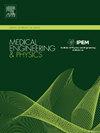Non-uniform assignment method for skeletal materials based on slope difference distribution and experimental validation
IF 2.3
4区 医学
Q3 ENGINEERING, BIOMEDICAL
引用次数: 0
Abstract
A modeling method of non-uniform material assignment based on Slope Difference Distribution (SDD) is proposed to establish a complete and effective finite element (FE) model of the lower limb tibia. The validity and accuracy of the model based on in vitro mechanical experiments are verified. An initial tibia model was established based on Computed Tomography (CT) images. The numerical distribution of the extracted Hounsfield Unit histograms of the tibia mesh elements was fitted as a smooth curve. The critical point of the slope difference distribution curve was computed and selected to establish a tibia FE model with non-uniform material properties through numerical variations. The composite tibia's area of interest was subjected to data acquisition and analysis of displacement and strain at three gaits through a Digital Image Correlation (DIC) device. The slopes of the stress-strain straight fitting lines for slope difference distribution and structural FE models are 47.17 and 36.45. A comparison of the results of the previous experiments revealed that the FE model based on the material assignment method of slope difference distribution is more accurate. The assignment method is not limited to tibia models but also provides a method for modeling other human bones and reduces the cost of mechanical testing for accurate prediction in the simulation of bone biomechanics.

基于斜率差分布的骨架材料非均匀分配方法及实验验证
为了建立完整有效的下肢胫骨有限元模型,提出了一种基于斜率差分布的非均匀材料分配建模方法。通过体外力学实验,验证了模型的有效性和准确性。基于计算机断层扫描(CT)图像建立了一个初始胫骨模型。将提取的胫骨网格单元Hounsfield单位直方图的数值分布拟合为光滑曲线。计算并选择斜率差分布曲线的临界点,通过数值变化建立非均匀材料特性的胫骨有限元模型。通过数字图像相关(DIC)装置对复合胫骨感兴趣区域进行三种步态下的位移和应变数据采集和分析。边坡差分布和结构有限元模型的应力-应变直线拟合线斜率分别为47.17和36.45。通过与以往试验结果的比较,表明基于斜率差分布的材料分配方法的有限元模型更为准确。指派方法不仅局限于胫骨模型,还为其他人类骨骼的建模提供了一种方法,并降低了在骨生物力学模拟中准确预测的力学测试成本。
本文章由计算机程序翻译,如有差异,请以英文原文为准。
求助全文
约1分钟内获得全文
求助全文
来源期刊

Medical Engineering & Physics
工程技术-工程:生物医学
CiteScore
4.30
自引率
4.50%
发文量
172
审稿时长
3.0 months
期刊介绍:
Medical Engineering & Physics provides a forum for the publication of the latest developments in biomedical engineering, and reflects the essential multidisciplinary nature of the subject. The journal publishes in-depth critical reviews, scientific papers and technical notes. Our focus encompasses the application of the basic principles of physics and engineering to the development of medical devices and technology, with the ultimate aim of producing improvements in the quality of health care.Topics covered include biomechanics, biomaterials, mechanobiology, rehabilitation engineering, biomedical signal processing and medical device development. Medical Engineering & Physics aims to keep both engineers and clinicians abreast of the latest applications of technology to health care.
 求助内容:
求助内容: 应助结果提醒方式:
应助结果提醒方式:


